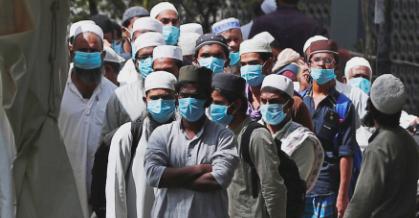The total number of Coronavirus disease cases has crossed 10,000 in India and the number of deaths count is more than 350. The spread of the disease has been very slow in India compared to other countries like the United States, Italy and the United Kingdom. There is no solid proof of what caused the disease to spread slowly in India but many publications have pointed out temperature, BCG immunization, food habits and early lockdown among the possible explanations of India being in a safe zone.
The majority of the cases in India come from a few states and Union territories like Maharashtra, Tamil Nadu, Rajasthan and Delhi. Corona spread in India would have been even slower but for spiked due to the Tablighi Jamaat event. Majority of the Coronavirus hotspots in the country are Muslim dominated localities where the infectious disease spread due to Tablighi or a due to a person returning person from gulf country.
In Mumbai, which accounts for more than half of Maharashtra’s 2,600 positive cases, many Muslim dominated slums such as Dharavi- largest slum of Asia with 15 Lakh people, Malegaon, Mankhurd and Deonar are emerging as hotspots.
Containment in these areas is a herculean task given the high population density and the uncooperative local population. “We are talking about a slum where 10-12 people live in 10×10 feet tin hutments. You can’t expect them to sit at home all day long,” Vinod Shetty, director at the non-profit Acorn Foundation, told Bloomberg.
Similarly in Tamil Nadu, which is only another state to reach in triple-digit with 1,204 cases, almost all the cases originate from ‘single source’ that is the Tablighi Jamaat event.
In Rajasthan, first Bhilwara emerged as hotspot thanks to the Italian tourist. But with the help of locals, the administration contained all cases through what became famous Bhilwara model. But the same model failed in Ramganj, a Muslim dominated locality in Jaipur which accounts for almost half of state’s total active cases. The disease spread in Ramganj from a person who returned from Oman on March 12.
“All cases from the Ramganj area can be traced to this person. He is responsible for passing on the infection directly to 17 people, including his family members, while one of his friends is suspected to have passed it onto almost a dozen people,” said Additional Chief Secretary (Health) Rohit Kumar Singh.
The Bhilwara model became successful due to cooperation by the local population and pro-activeness of the local administration. But in the Muslim dominated locality of Ramganj, the people have refused to provide crucial information to health workers because they were of the view that the government is collecting data for National Population Register (NPR) exercise. In fact, few locals have also attacked health workers for collecting information.
In Delhi, too, more than half of the cases can be traced to ‘single source’. The Union Territory has the second-highest number of cases having more than 1500 cases.
In Madhya Pradesh, the Muslim dominated locality of Indore, where the health workers were attacked, accounts for a majority of the state’s total cases apart from cases in state’s health department in Bhopal, where also the cases were traced to Indore.
In West Bengal, sprawling slum — Belgachia- in North Kolkata, was identified as the first hotspot to be sealed by Kolkata Police.
A religious break-up is unavailable, but if the Union government releases such data, more than half of the total infected people would come out as Muslims because most of the hotspots with a large number of cases are Muslim dominated ghettoized colonies.
There are three major reasons behind the spread of Corona. The first being how constantly one is exposed to an infected person; the second is physical proximity to an infected person, and the third is immunity.
In all three sections, Muslims fare poorly; thanks to their culture, poverty, and religious conservatism.
Majority of the Muslim families in India are poor and live in ghettoized colonies, as pointed out by the Sachar Committee report. Muslims have a very high reproduction rate and therefore, population density in Muslim colonies is very high.
Given the fact 10-15 family members live in a small house, most of the family members are constantly exposed to each other. The physical proximity to each other is also very high, thanks to their unhygienic practices.
Muslims perform a purification practice before offering namaz, called wudu. In most of the cases when they offer Namaj at a Masjid, there is a small water pool like area, where all the inmates would take water from to perform the ritual. They would wash their faces, mouth, feet and arms from the same pool. This leaves no doubt in our minds, and it becomes amply clear why the infection rate is so high among Muslims.
In the third criteria, that is immunity, Muslims fare badly due to their religious conservatism and opposition to vaccination, modern allopathic medicines, and excessive focus on meat in the diet.
Thus, owing to all these reasons, mostly hotspots today are Muslim-dominated regions in the country. The callousness of the Muslim community has put India into such a spot with more than 10,000 cases and more than 300 deaths in the country.
